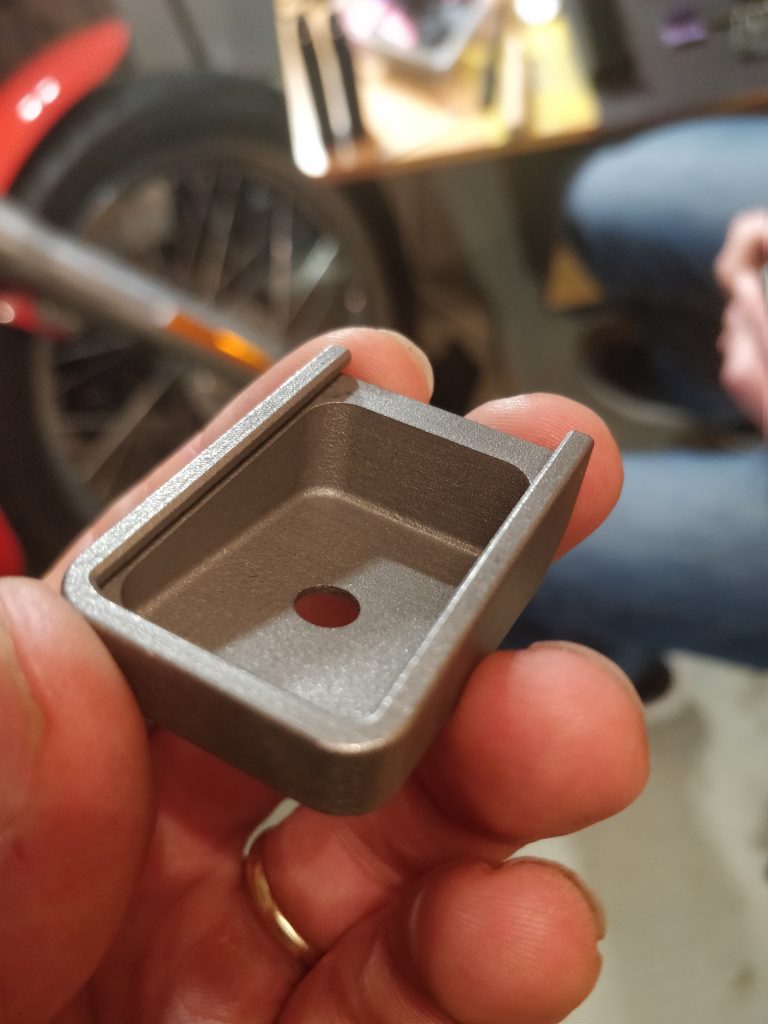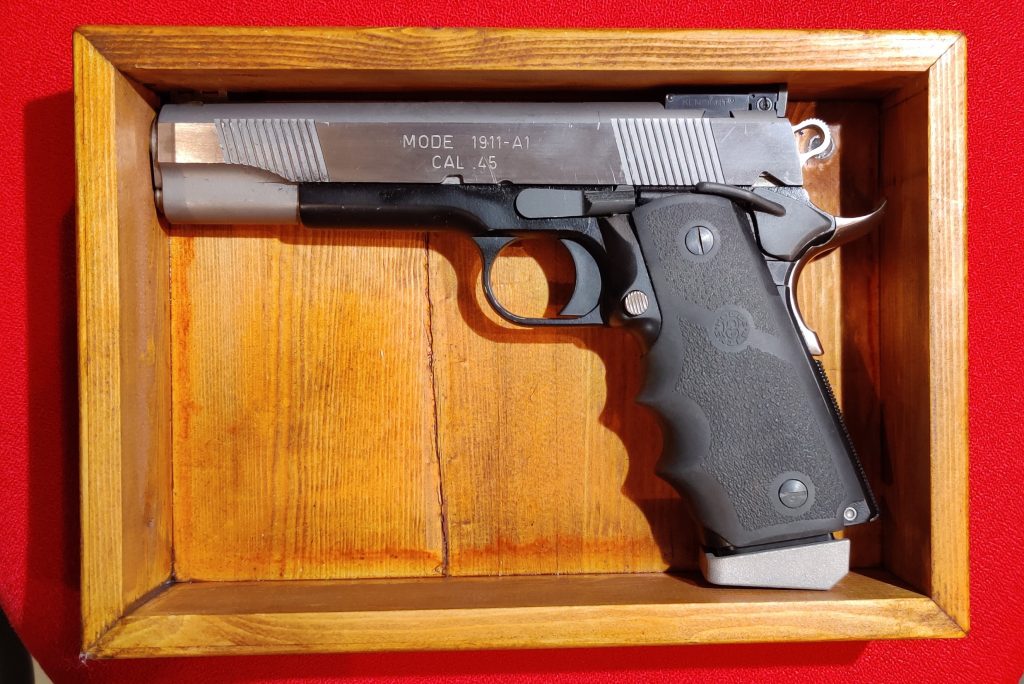
Caution! Contains a lot of WP auto translating.
Job description
SRA (sovellettu reserviläisammunta) and practical shooting (IPSC) can be practiced in other than shooting ranges. In this topic, this article focuses on the improvement of recreational equipment. The aim is to design and prepare a puncture-proof piece for the pistol, allowing more inputs to be placed on the visor weapon, so that the weapon is suitable for the Standard division of the practical shooting. The Standard division is conditional on the weapon being required to fit in Figure 1 in the Visible box (box dimensions 225 mm x 150 mm x 45 mm). Below is an excerpt from the Practical shooting pistol rules:
Special conditions for the Standard division:
- The pistol in its standby mode (see Rule 8.1), but the unloaded and empty box attached, or the roll closed (revolver), must be completely inside the drawer with dimensions of 225 mm x 150 mm x 45 mm (tolerance: + 1mm,-0mm). Please note that all magazines must comply with this.
- The competitor puts (and eventually removes) the pistol into the drawer so that the luist (or revolver barrel) is parallel to the longest side of the box. The adjustable rear sight can be slightly retractable, but the skate must be fully in front and all other parts of the gun (e.g. Folding sights, tuning handles, thumb rests, handles, etc.) Should be fully stretched or used when the weapon is in the box. In addition, telescopic magazines and magazines with a printed base plate are specifically prohibited.
Therefore, the base plate shown in Figure 1 was taken as the starting point of the work, but the target was better fit and more innovative attachment (the current brick is fixed with a small retaining screw). In addition, it was desired to design both a metallic and plastic version of the extension pieces.
Design
The design consisted of modeling with SolidEdge software and the production of prototypes in 3D printing. Initially, a rough outline was drawn, which was then finely tuned. The main thing was first to ensure a part of the suitability of the cap and the bow of the box. Thereafter, the bottom corner of the extension piece and the outer dimensions were expanded so that the box was better filled. In this way, maximum magazine capacity could be ensured. The design was also easy, as the final form was going step by stage. Figure 2 shows the design of a plastic extension with the SolidEdge program. At this point, the edges of the extension were too thick and the magazine did not stick to the weapon even though the sequel was agreed to a baseball gun. These high edges were therefore lowered and the piece started to be finished.

As mentioned, 3D models were based on a few 3D-printed prototypes. Figure 3 shows this type of prototype printed from pink plastic. As shown, the new extension of the box can be fairly fully charged.

When the model was satisfied, and both the metallic and plastic sequels were found to be suitable, it was time to move on to manufacturing.
Mainos alkaa
Mainos loppuu
Manufacture
There are several possible manufacturing methods: Machining with CNC milling machine, mold manufacturing and casting, and 3D printing. My original idea was to make the part by milling it with my own CNC milling device, but after my time, I came to the conclusion that it’s worth doing some with a 3D printer. To this I was led by two reasons, the preparation of a complex part of the milling machine is often demanding and time-consuming, and if the part is wrong, all work has been wasted. It is therefore wiser to manufacture at least the first part of the Produme with a 3D printer, because then the machine works independently. In addition, one of my friends assured me that modern 3D printers are capable of accurate and quality results. The extension cuts were made by printing them in metal, but it was also desired to create a more wobble plastic model alongside.
The preparation can be roughly divided into two parts: primary production and downstream production. Primary production consists of filling the first demand peak, where downstream production is responsible for spare parts etc. Need. At the outset, therefore, a sufficient number of components are desired at low unit costs, and in the future it is sufficient to produce individual parts at a slightly higher price, and therefore two different manufacturing methods were reached, one for primary production and the other To meet longer-term demand. First processed primary production.
3D printing with laser from metal
In primary production, a sufficient number of baseplates for effective race use was sought quickly and with a sideshow. Therefore, the parts were ended up printing metal in Finland. This method of manufacture offered a relatively inexpensive unit cost and high quality and strength. Fig. 4 shows the finished metal extension piece. The unit price of the piece came about €20.

Next, further production will be discussed.
Shapeway
The Shapeway service was chosen to fulfill the continued production needs. Although the price of the service is slightly higher than the selected primary production method, offers it a set of other benefits. The Shapeway service allows you to print 3D parts at the touch of a button. No need to ask friends for faves, no need to buy their own printer, just press the space button and part of the bump in the mailbag. The service is also upright around the clock and 3D models need to be downloaded there only once. Figure 5 shows the clip’s sequel to the Shapeway 3D preview. The service displays the size of the section and allows you to select the material (Fig. 5 and Fig. 6).
As shown in the following illustration, offers a Shapeway with a wide variety of materials and thus also a wide range of prices. When looking at prices, you can conclude that primary production offered a much cheaper metal output than the Shapeway. On the other hand, the plastic part is Shapewayssa roughly the same price as the metallic primary production.
In any case, the Shapeway service is ideal for ordering individual parts though it is unnecessarily expensive when ordering dozens or hundreds of parts. The final results of the initial and continuing production will be presented.
Mainos alkaa
Mainos loppuu
Results
Figure 7 shows a sequel to the final primary production. As the picture survives, fills this new model with rules to determine the box in the best possible way.

There are no further production components tested at the time of article writing. The purpose of further production was to respond to a potential spare part requirement and be reported when the need for spare parts is apparent. However, the following two views depicts the Shapeway service in my online store. These views show that the metal base can be purchased for about 40 euros and plastic for about 10 -20 euros.
In addition, my store has a spring release for sale. This seven-euro lipare comes into the box with a extension piece to keep the bow in place. At the same time, the Lipare locks the clip to the box frame. In this way, the extension piece remains in place without screws, which was not possible in the original design.
Summary
To summarize this project, you can say that it has been interesting to mix your own profession (the engineer) for your hobby (SRA). It’s also been interesting to get acquainted with the 3D printing of metals and see the finished part in their own vision. The metal extenders seem so durable that the parts of the Shapeway are likely to remain unused, except for the attachment. Also thanks for the project involved.



1 Comment
pg slot ทดลองเล่น · 14.12.2021 at 06:59
Hey There. I found your blog the usage of msn. This is a very well written article.
I will be sure to bookmark it and come back to learn extra of your helpful information. Thanks for the post.
I will certainly return.